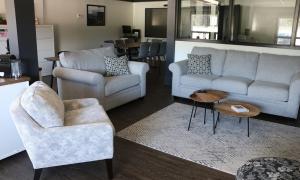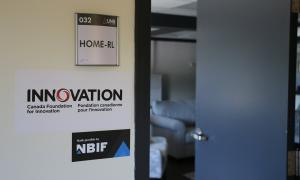When Julia Woodhall-Melnik established the Housing, Mobilization and Engagement Research Lab (HOME-RL) on the University of New Brunswick’s Saint John campus, she wanted to create a comfortable, unintimidating environment.
“Oftentimes, universities can be very sterile, institutional places,” explains Woodhall-Melnik, Canada Research Chair in Resilient Communities. “We wanted a space where we could welcome the community.” That’s because collaboration and community-based research is a big part of her work exploring the intertwined issues of housing affordability, poverty and mental health.

“We can’t truly understand something without connecting with those people who are actually living it,” she says. “We can’t be designing interventions for people without actually seeing what those people need, how they live, what they want.”
Since the CFI-funded lab opened in spring 2022, all kinds of people have grabbed a seat on one of the comfy couches that give the main area a home-like feel. Staff from local non-profits. The clients they serve. Members of tenant advocacy groups. Municipal and provincial politicians. Policy makers.
Those connections have led to more than a dozen different research projects that aim to improve quality of life for low-income people within New Brunswick and further afield.
Identifying intervention points to prevent housing loss
One example is the Maritime Community Housing and Health Initiative, commonly known as the “NB Housing Study.” This collaboration with the provincial Department of Social Development looks at the experience of people waiting for subsidized housing — a list that has grown from 4,750 to 11,000 over the last two years.
“What we’re finding out is that the situation is rather bleak,” says Woodhall-Melnik. Most of those on the waitlist report physical disabilities and mental illness, and many are contending with food insecurity. Now, she wants to launch a qualitative study to better understand how they’re coping.
“How do you leverage your resources to keep yourself housed? And what are those critical points when those resources no longer work for you?” she says. “Are there key intervention points where we can assist folks before they lose their housing?”
Creating safe housing for youth

Another project focuses on Saint John youth who are struggling to secure safe and affordable housing, due in part to a lack of reliable employment income or government funding. These teens and twenty-somethings often face serious consequences, as no housing makes it hard to pursue school or work and can create barriers to accessing supports.
At the Saint John Learning Exchange, program director Erin MacKenney had seen too many students dragging backpacks full of belongings to high school equivalency classes her organization runs. “They were coming to school. They were doing their best. But still, they didn’t have a safe place to go,” she explains.
So the Learning Exchange teamed up with other community organizations to create Safety First. This housing-first initiative helps youth live independently by providing subsidized rent, along with mentorship, skills development, mental health support, and education and employment programs.
Input from HOME-RL helped structure the research and evaluation components of the program. It also provided information on best practices involved in the housing-first model. “Getting that guidance was really important,” MacKenney says, adding that their staff appreciated working with the HOME-RL team to stay up to date on research.
“I’ve consulted with professors about things in the past, and they’ve given excellent advice. But this was different,” she continues. “This was purposeful, intentional partnership.”
Since July 2021, 45 youth have taken part in Safety First. Many no longer need rent subsidies, and all have gone on to employment, reengaged with school or improved their well-being. But as the availability of affordable rentals continues to drop across New Brunswick — and across the country — there’s so much more to do for low-income tenants of all ages.
The evaporation of affordable housing

Back in the lab, the HOME-RL team has crunched provincial rental numbers. Their analysis revealed a massive increase in the number of high-priced units at the top end of the market between 2011 and 2021, coupled with steep declines in units at the lower end.
Woodhall-Melnik attributes much of that to the huge growth in real estate investment trusts that are legally obligated to create returns for their investors.
“Decommodification of housing is the only way we’re going to resolve this,” she says. And that’s going to require political will. According to HOME-RL estimates, generating enough affordable units simply to replace those that have disappeared since 2011 would cost the provincial and federal governments between $1 billion and $3.5 billion, depending on how many units are bought or renovated and how many are built new. And that’s for a province of 800,000 people.
“It’s going to be uncomfortable,” Woodhall-Melnik warns. But it’s also essential — especially as climate-fueled disasters displace more people and home insurance rates climb beyond the reach of many residents.
“Everyone has the right to a safe, affordable, secure place to live,” MacKenney points out. “You cannot move forward in your life if you are always wondering if you’re going to have a place to come home to.”
The funding provided from CFI for the HOME-RL space has allowed us to cultivate a space on campus that is truly unique. [It] fosters collaboration and comfort, is welcoming to non-academics and students, and provides us with a [place to] connect with and work alongside our community partners, students, other researchers and staff.”
— Julia Woodhall-Melnik








